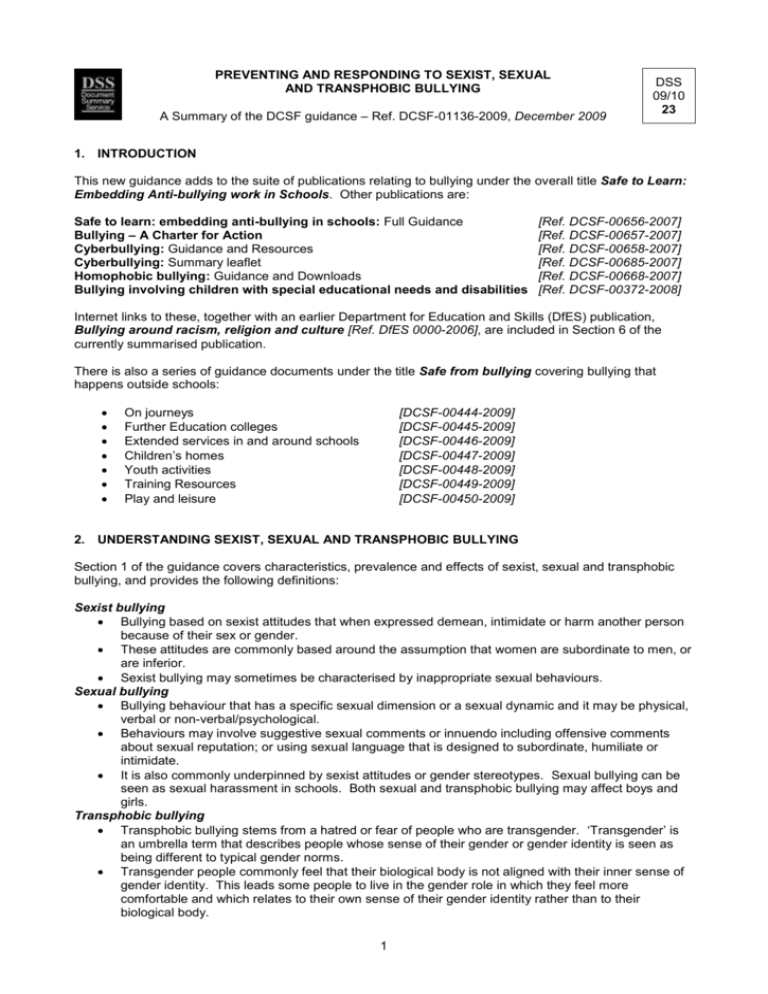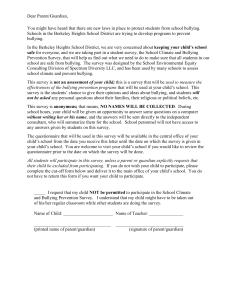
PREVENTING AND RESPONDING TO SEXIST, SEXUAL
AND TRANSPHOBIC BULLYING
A Summary of the DCSF guidance – Ref. DCSF-01136-2009, December 2009
DSS
09/10
23
1. INTRODUCTION
This new guidance adds to the suite of publications relating to bullying under the overall title Safe to Learn:
Embedding Anti-bullying work in Schools. Other publications are:
Safe to learn: embedding anti-bullying in schools: Full Guidance
Bullying – A Charter for Action
Cyberbullying: Guidance and Resources
Cyberbullying: Summary leaflet
Homophobic bullying: Guidance and Downloads
Bullying involving children with special educational needs and disabilities
[Ref. DCSF-00656-2007]
[Ref. DCSF-00657-2007]
[Ref. DCSF-00658-2007]
[Ref. DCSF-00685-2007]
[Ref. DCSF-00668-2007]
[Ref. DCSF-00372-2008]
Internet links to these, together with an earlier Department for Education and Skills (DfES) publication,
Bullying around racism, religion and culture [Ref. DfES 0000-2006], are included in Section 6 of the
currently summarised publication.
There is also a series of guidance documents under the title Safe from bullying covering bullying that
happens outside schools:
On journeys
Further Education colleges
Extended services in and around schools
Children’s homes
Youth activities
Training Resources
Play and leisure
[DCSF-00444-2009]
[DCSF-00445-2009]
[DCSF-00446-2009]
[DCSF-00447-2009]
[DCSF-00448-2009]
[DCSF-00449-2009]
[DCSF-00450-2009]
2. UNDERSTANDING SEXIST, SEXUAL AND TRANSPHOBIC BULLYING
Section 1 of the guidance covers characteristics, prevalence and effects of sexist, sexual and transphobic
bullying, and provides the following definitions:
Sexist bullying
Bullying based on sexist attitudes that when expressed demean, intimidate or harm another person
because of their sex or gender.
These attitudes are commonly based around the assumption that women are subordinate to men, or
are inferior.
Sexist bullying may sometimes be characterised by inappropriate sexual behaviours.
Sexual bullying
Bullying behaviour that has a specific sexual dimension or a sexual dynamic and it may be physical,
verbal or non-verbal/psychological.
Behaviours may involve suggestive sexual comments or innuendo including offensive comments
about sexual reputation; or using sexual language that is designed to subordinate, humiliate or
intimidate.
It is also commonly underpinned by sexist attitudes or gender stereotypes. Sexual bullying can be
seen as sexual harassment in schools. Both sexual and transphobic bullying may affect boys and
girls.
Transphobic bullying
Transphobic bullying stems from a hatred or fear of people who are transgender. ‘Transgender’ is
an umbrella term that describes people whose sense of their gender or gender identity is seen as
being different to typical gender norms.
Transgender people commonly feel that their biological body is not aligned with their inner sense of
gender identity. This leads some people to live in the gender role in which they feel more
comfortable and which relates to their own sense of their gender identity rather than to their
biological body.
1
Where children and young people are perceived not to be conforming to the dominant gender roles
that may be widely expected of them, schools should be alert for signs of bullying.
Transphobic bullying is commonly underpinned by sexist attitudes. Boys and girls may be equally
affected. An individual may also experience transphobic bullying as a result of perceptions that a
parent, relative or other significant figure displays gender ‘variance’ or is transgender.
3. THE LAW
Section 2 of the guidance summarises the legal and statutory frameworks regulating schools’ duties
regarding bullying, and is headed by these key messages:
Schools have a legal duty to take measures to prevent all forms of bullying, including sexist,
sexual and transphobic bullying, and to protect pupils from harm, and ensure their physical and
mental health and well-being.
There are also a number of pieces of equalities legislation that establish the specific
responsibilities a school has to tackle discrimination.
Schools have the power to exclude pupils involved in bullying and/or cases involving sexual abuse
or assault, and the legal powers of schools in this area are summarised in this section.
Sexist, sexual and transphobic bullying may have wider safeguarding implications, or involve
criminal behaviour, and in these cases schools need to engage the appropriate safeguarding
agencies and/or the police.
4. PREVENTING AND RESPONDING TO SEXIST, SEXUAL AND TRANSPHOBIC BULLYING
Section 3 is the heart of the guidance, and offers detailed advice on:
Preventing:
a) Creating a whole school approach
b) Planning the curriculum to address and prevent sexist, sexual and transphobic bullying
c) Working in partnership: involving a range of agencies
Responding:
a) Supporting the child or young person experiencing bullying
b) Responding to pupils who engage in bullying behaviour
c) A whole school response: learning from incidents of sexist, sexual or transphobic bullying
The key messages for schools are:
Preventing and responding to bullying should be seen as one overarching process – effective
responses inform effective prevention work.
Schools need to make effective use of the curriculum effectively to prevent sexist, sexual and
transphobic bullying, and address some of the underlying attitudes that may underpin these forms of
bullying.
Responses to sexist, sexual and transphobic bullying need to address and support the individual or
group who have experienced bullying (and possibly their families), the individual or group engaging
in bullying behaviour (and possibly their families) and the wider school community. Schools should
always assess whether a referral to children’s services safeguarding agencies or specialist support
services is necessary in cases of sexist, sexual and transphobic bullying.
Issues of confidentiality and responding appropriately to sensitive issues and disclosures are
especially relevant to sexist, sexual and transphobic bullying.
In Responding, the following sequence is recommended for a member of staff’s response to a pupil who
reports this kind of bullying:
Find a place where you will not be interrupted.
tell the pupil you are worried about them
ask them to tell you about the bullying
listen in a non-judgemental way
tell them no-one should have to experience that sort of bullying
tell them the school will help them stop the bullying
encourage them to agree to the incident being formally logged through the school’s system for
recording bullying incidents
2
ensure the safety of the child or young person is secure immediately after the incident, including on
the way home from school
seek further support from other school staff as needed.
This is further elaborated in Annex B: a ‘practice snapshot’ of material to be included in a Staff Handbook
on handling sensitive information and issues.
On Challenging unacceptable language or attitudes, the following structured prompts for use by staff are
offered, (adapted from: The Sexuality Project – Brighton and Hove and East Sussex PSHE Advisory Team,
2000):
1) Dismissive response
‘I’m not going to listen to language like that.’
2) Questioning response
‘What makes you think that?’
‘What do you mean by that?’
‘Let’s talk about why people think like that.’
3) Confronting response
‘Language like that is not acceptable.’
‘A lot of people would find that offensive.’
4) Personal response
‘I’m not happy with what you said.’
‘I find that language really offensive.’
‘What you’ve said really disturbs me.’
5) Organisational response
‘The school doesn’t tolerate language like that.’
5. RECORDING AND REPORTING SEXIST, SEXUAL AND TRANSPHOBIC BULLYING
Section 4 of the guidance addresses organisational and management issues of recording and reporting
incidents of bullying. It includes proposals to introduce, (following consultations), a new statutory duty on
schools [under the Education Act 2002] to record incidents of bullying between pupils, and incidents of
verbal or physical abuse against school staff. The key features of an effective school reporting system
are outlined, and Annex D provides a ‘practice snapshot’ – a sample staff script used by schools to support
the process of recording and reporting incidents of sexist, sexual or transphobic bullying.
The complete guidance can be viewed/downloaded at:
http://www.dcsf.gov.uk > Entering 01136-2009 in the Search field.
© Document Summary Service 2010. University of Bristol Graduate School of Education, 35 Berkeley Square, Bristol, BS1 8JA.
3









